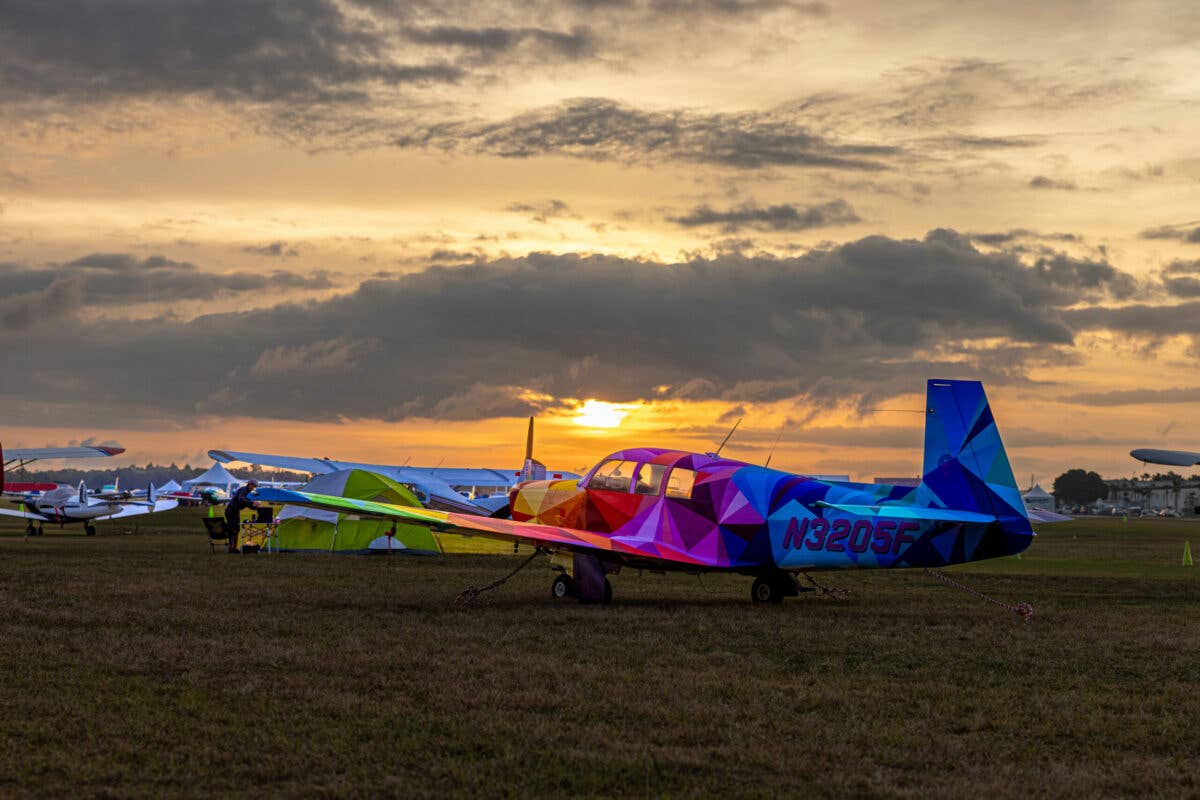Rainbow Mooney Makes the Airshow Scene
A 1967 Mooney M20F painted by a muralist is getting noticed.

Will “Liam” Hawkins’ 1967 Mooney M20F is covered with triangles in every color of the rainbow—and then some. [Credit: Stephen Yeates]
"What color is your airplane?"
This is not a simple question for Will "Liam" Hawkins, who flies a 1967 Mooney M20F based at Albert Whitted Airport (KSPG), St. Petersburg, Florida. The airplane is covered with triangles in every color of the rainbow—and then some. The Mooney drew lots of attention during Sun ‘n Fun and was certainly one of the most photographed aircraft in attendance.
Hawkins, a 650-hour private pilot, purchased the airplane a little over a year ago, and set about refurbishing it from the inside out. He chose the Mooney because he was looking for an aircraft that was "Somewhat efficient, speedy, reasonable to maintain with a well established pilot/owner community."
"The Comanche, Arrow, Mooney M20s, and even Cessna 182 were in the running, but I was definitely zeroing in on Mooney," he said, adding, "When I saw a Mooney with a recently overhauled engine and prop at a price in my range, the process began."
He considered himself lucky to get it, because at the time airplanes were being sold almost as fast as they were being listed.
Geometric Shapes, Lots of Color
When he acquired the Mooney it had a basic paint job, a stripe here and there and "mostly original cockpit instruments. Hawkins’ renovations began in the cockpit, with a modernization of the panel to allow for ease of both VFR and IFR flight.
"We stripped out the entire panel and the vacuum system," he recalled. "replacing it all with a Garmin suite. Garmin G3x, GNC 355, GFC500 autopilot, GNC 255, G5 for backup, Garmin radio panel, Garmin transponder, GSB15 USB ports, etc."
For the seats, Hawkins sought the expertise of Gemico Decorative Trim in Tampa, Florida, and Bruce Jaeger, well known in the Mooney community, for the “Mooney Spatial Interior.”
"Bruce himself, who is retired, drove up from Fort Myers to handle the install of his panels, refurb of upper panels, and installation of carpeting," Hawkins said.
The paint job grew out of a discussion with a friend, Matt Kress, who is a mural artist.
"Matt said, 'if you ever paint your plane someday, let me know as I'd love to paint it for you'."
Hawkins is a fan of Matt’s creative style and trusts the quality of work.
"We discussed very basic concepts, and it basically came down to me saying 'I’d like geometric shapes and lots of color.' When we were about to discuss more details and work on mock-ups, I decided that I’d rather let Matt just do what he does and not interfere with his creative process—just let him flow. I even asked both him and the paint shop to not provide me with any visual updates. I literally had no clue what the airplane looked like until the day I went to pick it up. I have goosebumps now even just thinking about how thrilled I was at the reveal."
It was a challenge getting to that point, said Hawkins, because most of the paint shops he called did not allow independent painters to use their facilities.
"I called around to some shops, asking if they would do the usual steps and, once the aircraft is basecoat white, allow Matt to work in their shop for a few weeks. Shops treated me like I was out of my mind—they did not want to have a third party working onsite or interrupting the workflow—and they certainly did not want to warranty the work. As a business owner, I understood their position."
The exception was Ace Aircraft Refinishing in Bartow, Florida.
"Co-owner Luke Strawbridge was thrilled with the idea," Hawkins recalled. "He was eager to connect with Matt, offer a dedicated hangar for Matt to work in, and even ordered samples of his paint so that he could test, and, ultimately, warranty the combined work. Everything went so well with Matt and Luke that they aim to work together on more creative airplane paint jobs."
The Technique
According to Hawkins, the geometric pattern was achieved by masking off a portion of each shape and allowing overspray towards an area yet-to-be-painted.
"This allowed Matt to cut the duration of his effort down significantly. Matt’s portion was done in under three weeks—and that includes painting the bottom of the wings and fuselage."
"Everything was standard aviation paint process up until Matt’s paint, which is graffiti artist spray paint in shaker cans from a brand called Montana Colors," Hawkins said. "On top of Matt’s colorful paint is two layers of clearcoat that Ace uses on all of their airplane paint jobs—so it’s basically just standard clear coat that I’m wiping down daily."
The Reaction
The airplane is an attention-getter, said Hawkins.
"Every tower asks me about it. If I open up my hangar door, nearly anyone walking, biking, or driving by stops to ask questions. The plane sat in the avionics shop for a day this week for some updates and the shop said the amount of people coming by and asking questions became disruptive," he said. "Brands have offered endorsement/sponsorship deals. And the reaction on the internet has been fantastic."
According to Hawkins, the usual reaction starts with “Wow! That’s amazing!" then proceeds to technical questions such as “Is that a wrap or paint,” followed by “Is your airplane for sale?” and the big Kahuna: “How do you list the color on flight plans?”
Hawkins adds he'll need to figure it out quickly, as he plans to fly the multicolored Mooney to Oshkosh, Wisconsin, this year for the annual EAA AirVenture convention.

Sign-up for newsletters & special offers!
Get the latest FLYING stories & special offers delivered directly to your inbox






